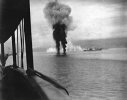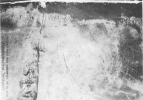My old man flew FM’s off of a CVE in the final months of the war. The Wildcat actually had a great reputation with the Japanese who considered it a comparable fighter to their own Zero. As @Llarry notes, it was the American ability to innovate tactically that secured the South Pacific during the first 24 months of the war while flying soon-to-be surpassed fighters like the F4F and P-40. On an interesting side note, the glamorous P-51 was not highly regarded in the Pacific, where pilots and ground crew found it too picky and flimsy for the harsh environment.As we all probably recollect, on December 7, 1941, the standard Navy fighter was the Grumman F4F-3 Wildcat.
Install the app
How to install the app on iOS
Follow along with the video below to see how to install our site as a web app on your home screen.
Note: This feature may not be available in some browsers.
-
Please take a moment and update your account profile. If you have an updated account profile with basic information on why you are on Air Warriors it will help other people respond to your posts. How do you update your profile you ask?
Go here:
Edit Account Details and Profile
You are using an out of date browser. It may not display this or other websites correctly.
You should upgrade or use an alternative browser.
You should upgrade or use an alternative browser.
WWII history and tactics
- Thread starter Uncle Fester
- Start date
Today, and the next two days, mark the anniversary of the hard fought and deadly series of naval engagements at Guadalcanal. The fight to take and keep Guadalcanal was key to securing the flank of the entire battle for the South Pacific (1942 to 1943). It was here that the famous Cactus Air Force eventually changed the course of the war.


And Wildcats played a huge role. Joe Foss flew his into history. I had the honor of meeting Gen Foss a few times as he was the uncle of a good friend. awesome man. Incredible life.It was here that the famous Cactus Air Force eventually changed the course of the war.
USS Washington BB-56 under the overall command of Rear Admiral Willis Lee opening fire on IJN Kirishima at point blank range just after midnight.Today, and the next two days, mark the anniversary of the hard fought and deadly series of naval engagements at Guadalcanal. The fight to take and keep Guadalcanal was key to securing the flank of the entire battle for the South Pacific (1942 to 1943). It was here that the famous Cactus Air Force eventually changed the course of the war.
View attachment 43903

USS Washington BB-56 under the overall command of Rear Admiral Willis Lee opening fire on IJN Kirishima at point blank range just after midnight.
View attachment 43904
I find it fascinating that as good as the Japanese were at night surface battle at the time the one 'evenly matched' battleship versus battleship duel of the entire Pacific war ended with an emphatic US victory. There was a lot of luck involved but Admiral Lee's and the crew's skill was the deciding factor, while not a 'significant' victory in the grand scheme of things it is still a magnificent one.
The battle also showed how well 'peak' battleship armor performed, with the South Dakota taking a beating but able to sail away with only moderate damage (albeit with one big ass dent on the aft main gun turret barbette from an almost direct 14 inch shell hit) and relatively light casualties.
Photo 35: Hit No. 26. Point of impact of projectile on barbette No. 3.

I find it fascinating that as good as the Japanese were at night surface battle at the time the one 'evenly matched' battleship versus battleship duel of the entire Pacific war ended with an emphatic US victory. There was a lot of luck involved but Admiral Lee's and the crew's skill was the deciding factor, while not a 'significant' victory in the grand scheme of things it is still a magnificent one.
The battle also showed how well 'peak' battleship armor performed, with the South Dakota taking a beating but able to sail away with only moderate damage (albeit with one big ass dent on the aft main gun turret barbette from an almost direct 14 inch shell hit) and relatively light casualties.
Photo 35: Hit No. 26. Point of impact of projectile on barbette No. 3.
View attachment 43905
There is a whole other podcast discussing Lee and his career.
Good point. The way the Japanese focused exclusively on South Dakota reminds me of Midway where all of the Zeroes went down to chase torpedo bombers while no one maintained watch or discipline to stay alert and guard against dive bombers.I find it fascinating that as good as the Japanese were at night surface battle at the time the one 'evenly matched' battleship versus battleship duel of the entire Pacific war ended with an emphatic US victory. There was a lot of luck involved but Admiral Lee's and the crew's skill was the deciding factor, while not a 'significant' victory in the grand scheme of things it is still a magnificent one.
The battle also showed how well 'peak' battleship armor performed, with the South Dakota taking a beating but able to sail away with only moderate damage (albeit with one big ass dent on the aft main gun turret barbette from an almost direct 14 inch shell hit) and relatively light casualties.
Photo 35: Hit No. 26. Point of impact of projectile on barbette No. 3.
View attachment 43905
As for the battle, a “what if” was if the Yamato was present instead of Kirishima. The South Dakota would not have survived- but I don’t think even Yamato’s elephant armor could have withstood Washington’s superheavy 16” shells at only 8,000 yards. Considering the Washington hit on the first salvo and probably would’ve pumped 3 or 4 salvos into the Japanese giant before Yamato could even register what was going on, who knows.
One of the luckiest things about the battle was that the Japanese destroyers launched 2 separate spreads of 30+ Long Lances at the battleships- all missed.
Lee was a weaponized nerd.I find it fascinating that as good as the Japanese were at night surface battle at the time the one 'evenly matched' battleship versus battleship duel of the entire Pacific war ended with an emphatic US victory. There was a lot of luck involved but Admiral Lee's and the crew's skill was the deciding factor, while not a 'significant' victory in the grand scheme of things it is still a magnificent one.
The battle also showed how well 'peak' battleship armor performed, with the South Dakota taking a beating but able to sail away with only moderate damage (albeit with one big ass dent on the aft main gun turret barbette from an almost direct 14 inch shell hit) and relatively light casualties.
Photo 35: Hit No. 26. Point of impact of projectile on barbette No. 3.
View attachment 43905
Perfect example of how technical leadership could turn newfangled widgets into things with deadly effect. Lots of that forced to happen in WW2 really.
Very much like Pappy Gunn, creator of the A-20 and B-25 “gun ship” and skip bombing. Of course he was a naval aviator!Lee was a weaponized nerd.
Perfect example of how technical leadership could turn newfangled widgets into things with deadly effect. Lots of that forced to happen in WW2 really.
